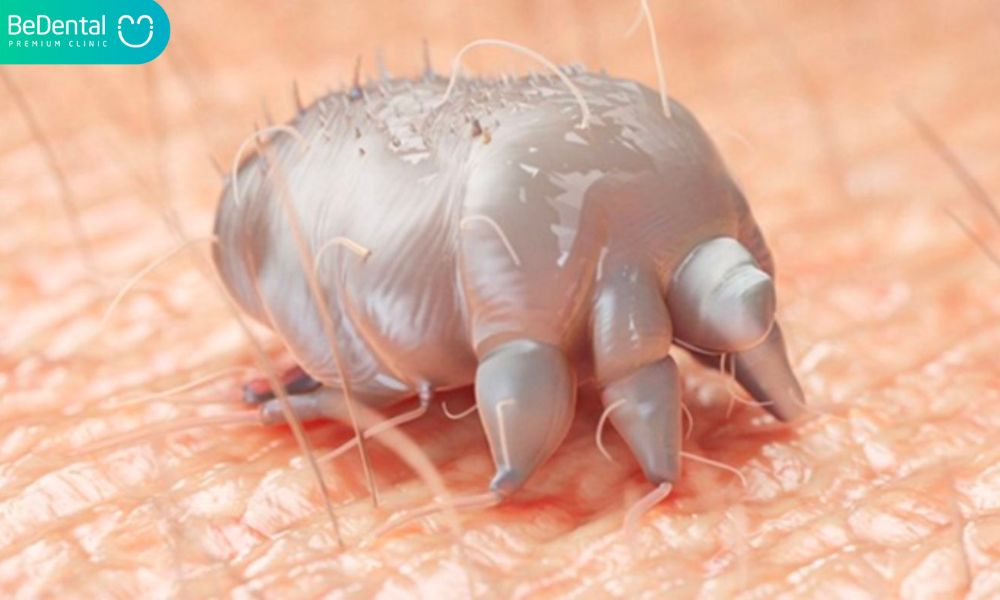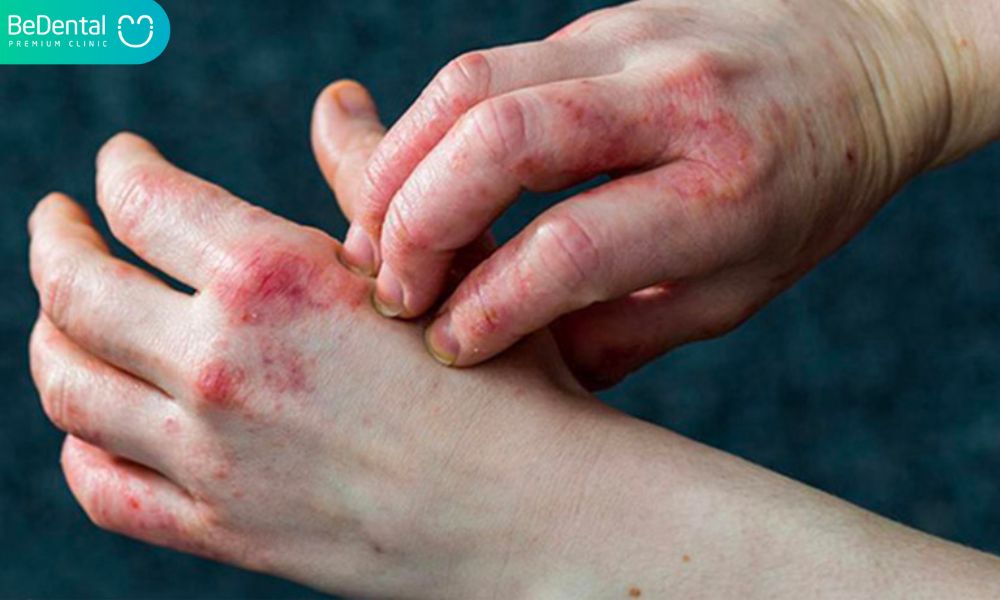Scabies disease, also known as “itch mite infestation,” is a common skin condition that can cause various dangerous complications to health, such as kidney inflammation, bloodstream infection, etc. Therefore, it is important to recognize and treat the disease early in order to successfully eliminate the causative agent and prevent complications.
1. What is scabies?
“Scabies” is the term used by people to refer to a dermatological condition characterized by small water-filled blisters on the skin, most commonly occurring in areas of thin skin.
This disease is particularly dangerous for children under 4 years old, as their skin is still fragile and susceptible to infestation by the parasitic mites that cause scabies. If not treated promptly, the disease can have serious consequences. Scabies is most prevalent during the rainy or winter season, especially in children.
Scabies disease is classified into three main forms, including:
- Classic scabies: This is the most common form of the disease, often appearing on areas of the skin such as hands, feet, and other locations, causing itching but not resulting in serious complications.
- Crusted scabies: This form of the disease commonly appears around the genital area, armpits, and is accompanied by signs of infection and severe itching.
- Norwegian scabies: This is a rare form of the disease, characterized by gray scales on the skin, usually occurring in individuals with weakened immune systems.
2. Causes of scabies
According to experts, scabies develops in two different stages. If not treated promptly, the scabies blisters can burst, causing abrasions and leaving scars on the skin.

The first stage of Scabies disease does not have clear visible signs on the body, only increased itching and scratching at night. Then, the disease progresses to the second stage, where horizontal and vertical lines, resembling a cross, appear on the skin in a grayish-white color, measuring a few millimeters in length.
These lines contain water-filled blisters, which serve as hiding places for scabies mites. When infected with scabies, initial symptoms often include mild fever.
Subsequently, numerous water blisters will appear on the skin, appearing all over the body, especially in areas with thin skin such as the buttock folds, wrist joints, fingers, palms, and underarms. If children scratch extensively, the scabies blisters can burst, leading to skin ulcers or abrasions.
3. Recognizing the signs of scabies
Typically, after coming into contact with the parasites, the first symptom of the disease is a tingling sensation on the skin, especially at night. The cause of this symptom is the parasite creating a 2-3cm long burrow in the horny layer of the skin, known as a scabies burrow.
This burrow is opaque white or grayish and slightly raised above the skin, not matching the skin texture. The water blisters at the end of the burrow are the parasite’s residence.
When infected, the burrows usually appear in the wrist folds, between the fingers, along the palm creases, and on the glans. By injecting fluid into the blisters, the parasites can be captured on a needle. However, these symptoms often appear after several weeks of contact with the parasites.
Symptoms of scabies on the skin usually begin with itching sensations, followed by the appearance of small red water blisters that form burrows under the skin. However, these symptoms may not always be present.

The common areas on the body where Scabies disease usually occur are the hands, feet, spaces between the fingers and toes, waist, groin, areas around the genitals, buttocks, and folds of skin on the body.
Scabies outbreaks typically occur at night and cause the affected person to feel uncomfortable itching. This happens when the Scabies disease mites move on the skin and stimulate the nerve endings, causing itching sensations. Additionally, when the mites burrow under the skin to lay eggs at night, it releases toxins that intensify the itching, making the affected person feel more uncomfortable and in pain.
4. Causes of Scabies disease
Scabies disease is an infectious disease caused by the parasite Sarcoptes scabiei. It can easily be transmitted through contact with an infected person or their belongings. After laying eggs on the skin, the larvae will develop and mature within a few weeks.
When the parasites burrow under the skin to lay eggs at night, the affected person will experience itching and discomfort, especially at night. Scabies can develop due to various reasons, including:
Dirty and polluted living environments
To maintain healthy skin, experts recommend that living environments should be kept clean and hygienic. Places with polluted air, contaminated water, or lots of dirt have a higher risk of scabies infection.
Therefore, to prevent skin diseases, it is essential to ensure that we live in a safe and healthy environment.
Living in overcrowded conditions
In addition to the negative impact of environmental pollution, living in crowded environments with limited space and poor air circulation is also a risk factor for skin diseases.
Lack of personal hygiene
Personal hygiene is crucial in preventing scabies. If we do not regularly clean our bodies, it makes it easier for parasites to invade and cause diseases.
Harsh living environments
Areas that are frequently affected by harsh weather conditions such as floods or heavy rain are favorable environments for the development of parasites, insects, and harmful viruses that can affect human health.
5. Complications of scabies
Scabies does not pose a threat to the patient’s life, but it causes pain and reduces the quality of life for those infected. Since the mites burrow and lay eggs at night, patients will experience intense itching and discomfort, leading to sleeplessness. In addition, scabies blisters cause aesthetic problems, as they cause redness, pus-filled bumps, scaly and flaking skin all over the body.
Therefore, when experiencing symptoms of scabies, it is important to seek appropriate treatment methods to minimize the impact of the disease on the quality of life.
6. Distinguishing scabies disease from other skin diseases
Scabies can easily be confused with other skin diseases such as fungal infections, atopic dermatitis, or lice. Therefore, to detect the disease early and prevent its spread, it is important to differentiate the various symptoms.
It is crucial to quickly take the affected person to see a doctor for diagnosis and timely treatment. Some factors to consider in distinguishing scabies disease from other skin diseases include:
Lice:
Similar to scabies, lice also have similar symptoms on the skin. However, the water blisters in lice infestation will be different from scabies. They are usually small, hard to burst, and appear in large clusters or scattered in locations such as hands, fingers, and feet.
If these symptoms are observed, the affected person should seek medical attention for an accurate diagnosis and timely treatment.

Itching rash:
Itching rash is a common symptom of dermatitis, a skin condition caused by various factors such as insect bites, food allergies, or contact with chemicals.
Skin lesions can appear anywhere on the body and often include small, red or white rashes, and can ooze if scratched. The itching sensation is very uncomfortable and reduces the quality of life for the affected person.
Dermatitis:
Dermatitis and scabies have similar symptoms but different causes. Dermatitis is a type of skin allergy, while scabies disease is caused by a parasitic mite.
In addition, the symptoms of dermatitis often occur in episodes, causing dry and itchy skin. Small rashes will appear on the skin, ooze when scratched, and then become scaly.
Fungal infection:
Fungal infection is a disease caused by fungal bacteria, usually appearing in areas of the skin with keratin such as hair, nails, and skin. Symptoms of fungal infection include round, red spots with clear borders and small water blisters at the edges.
Similar to scabies, the affected person will feel itchy and uncomfortable. When scratched extensively in the affected area, fluid will ooze out, sometimes with pus.

Syphilis:
Syphilis often appears in the genital area and causes small ulcers that are round or oval in shape and have a pink or red color. These ulcers typically develop around the anal area and the genital area of the affected person.
Unlike scabies, syphilis does not cause itching or pain, but it can still be uncomfortable and requires timely treatment.
7. Treatment for scabies
- Treatment for scabies: Western medicine treatment
To treat scabies, the common treatment method in Western medicine is to use topical medications to kill parasites and support skin regeneration, such as:
Topical creams: D.E.P, Lindane 1%, Benzyl Benzoate 33%, Eurax cream, Permethrin 5% cream, Crotamiton 10%…
Combination oral medications: Some patients may be prescribed antibiotics, H1 antihistamines, or multivitamins to support treatment.
- Treatment for scabies: Traditional Chinese medicine treatment
To treat scabies using traditional Chinese medicine methods, patients can consider the following herbal remedies:
Herbal remedy 1: Herbal mixture consisting of 50g of Honeysuckle, 50g of Licorice, and 100ml of olive oil. After boiling the ingredients together, the patient can apply the mixture evenly to the affected skin twice a day.
Herbal remedy 2: Herbal mixture consisting of 20g of Coptis root, 20g of Skullcap, and 100ml of grain alcohol. Prepare the ingredients into a tincture and apply it to the skin twice a day.
- Treatment for scabies: Folk remedies
Treating scabies with herbal remedies has been passed down from generation to generation. One of the most effective folk remedies is the use of guava peel, vinegar, and betel leaf.
These ingredients are lightly boiled and applied to the affected areas of the skin. This method has been proven and recognized for its ability to effectively treat the disease.
Betel leaf – A safe method for treating scabies.

Betel leaf is a herbal remedy that is very effective in treating scabies, especially in children and infants. This is because betel leaf has soothing and anti-inflammatory properties.
To use betel leaf for treating scabies, you need to prepare 3-4 betel leaves and wash them thoroughly. Then, finely chop the leaves to extract the essential oil and put it in a bowl. Pour boiling water into the bowl of betel leaves and steep for about 15-20 minutes.
When the betel leaf water has cooled down, you can use it to clean the affected skin in children. You can also gently rub the leaf residue on the wounds to allow the essential oil in the betel leaf to take effect.
If using for adults, you can add a little salt to the betel leaf water to enhance its antibacterial properties. Apply this method regularly for 4-7 days, and you will see improvement in symptoms.
Using betel leaf is a safe and effective method for treating scabies, especially for children, as it does not cause skin irritation.
8. How to prevent scabies disease ?
How to prevent scabies? To protect our skin and health, we should adhere to the following personal hygiene habits. First, use personal items to avoid sharing with other family members. This will help reduce the risk of transmitting infectious diseases.
In addition, the living environment and activities should be cleaned regularly to ensure there is no harmful dirt for our health. Clothes should also be washed and exposed to sunlight to kill bacteria. If you suspect clothes are contaminated with the disease-causing agent, dispose of them immediately to prevent the spread of the disease.
We should also avoid contact with people who have scabies disease to prevent the spread of the disease. If contact cannot be avoided, wear gloves and protect the skin well.
Remember not to use topical medications without a doctor’s prescription. Improper use or purchasing the wrong type of medication can worsen the condition.
Finally, strengthen the immune system by consuming a balanced diet and regularly exercising. This will help the body fight against infectious diseases and improve overall health.
9. Is scabies contagious and dangerous?
Scabies is an infectious disease, and its symptoms can spread from the affected skin to other areas of the body. In addition, scabies disease can be transmitted from person to person through the following two routes:
- Direct transmission: Scabies can spread directly if you have gestures such as hugging, kissing, bathing together, or having sexual contact with an infected person.
- Indirect transmission: Sharing clothes, towels, face towels, or sharing a bed with an infected person is also one of the causes of scabies transmission.

Scabies has more serious implications for health. If the disease is not detected and treated in a timely manner, it can lead to skin infections, skin ulcers, and widespread damage, increasing the risk of acute kidney inflammation.
10. Some notes in caring for scabies
In addition to following the treatment regimen, individuals with scabies disease should take some notes in caring for scabies disease .
- Adjusting diet: Consuming foods rich in zinc, such as oats, cereals, and beef, can help boost immunity and reduce symptoms of the disease. It is recommended to eat plenty of fruits and vegetables and drink enough water. Additionally, it is important to limit the consumption of spicy and fried foods, as well as seafood, to avoid skin irritation.
- Regularly maintaining skin hygiene: Keeping the skin clean is an effective way to prevent the spread of the disease. It is important to use appropriate hygiene products and avoid excessive rubbing of the affected skin.
- Avoiding contact with allergens: Allergens such as pollen, animal fur, and dust can cause skin irritation, so it is necessary to stay away from them. Regular cleaning and maintenance of the home can help reduce the accumulation of these allergens
Tư vấn chuyên môn bài viết:
TS.BÁC SĨ NGUYỄN HỮU QUANG
BEDENTAL - TOP STANDARD DENTISTRY SYSTEM
In HANOI
Address 1: 7B Thi Sach St, Ngo Thi Nham, Hai Ba Trung Dist, Ha Noi. - 0934.61.9090
Address 2: No 129 Hoang Ngan, Yen Hoa, Cau Giay Dist, Ha Noi. - 0934.61.9090
In HO CHI MINH
Address 1: 53 -55 -57 Pho Duc Chinh St, Nguyen Thai Binh, Dist. 1, Ho Chi Minh. - 0766.00.8080
Working: 9am - 8pm everyday
Website: https://bedental.vn/en/






Pingback: Can teeth whitening be done after dental filling? – Be Dental
Pingback: What is dental material? Where to buy reliable and quality dental materials? – Be Dental
Pingback: What is Boganic? What are the effects of Boganic? – Be Dental
Pingback: Instructions for using Kin Gingival mouthwash to prevent gum inflammation 250ml – Be Dental
Pingback: What should I do if I lose Tooth Number 7 in the upper or lower jaw? – Be Dental
Pingback: Permanent Tooth Decay Treatment? Causes and Remedies? What is the Best Way to Permanently Fill Cavities? – Be Dental
Pingback: Do Baby Canines (Eruption) Change? What Parents Need to Know About Baby Canine Teeth Eruption in Children. – Be Dental